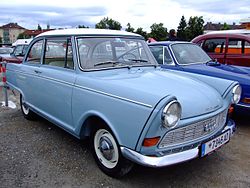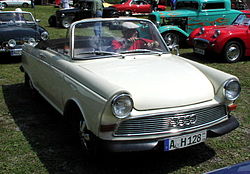- DKW Junior
-
DKW Junior
DKW F11 / DKW F12
Manufacturer Auto Union AG Production 1959–1963 (Junior)
1963–1965 (F11 / F12)Body style 2-door saloon
2-door cabrioletLayout FF layout Engine 741 cc two stroke straight-3 [1]
796 cc two stroke straight-3
889 cc two stroke straight-3Transmission 4 speed manual Wheelbase 2,175 mm (85.6 in) Junior
2,250 mm (89 in)F11/F12Length 3,968 mm (156.2 in) Curb weight 700 kg (1,500 lb)- 770 kg (1,700 lb) (empty) The DKW Junior was a small front wheel drive saloon manufactured by Auto Union AG. The car received a positive reaction when first exhibited, initially badged as the DKW 600, at the Frankfurt Motor Show in March 1957. The ‘Junior’ name was given to the (by now) DKW 750 in 1959 when the car went into volume production, but failed to survive an upgrade in January 1963, after which the car was known as the DKW F12. In addition to the saloon, a pretty ‘F12 Roadster’ (cabriolet version) was produced in limited numbers.
The car was known for its two stroke engine. A number of European auto-makers produced two-stroke powered cars in the 1950s, but by the time the DKW Junior came along, the market was beginning to resist two-stroke powered cars as the industry increasingly standardised on four stroke four cylinder units which accordingly were becoming cheaper to produce. Two stroke engined cars were perceived by some as rough and noisy by comparison.
Contents
The DKW line-up
In terms of its size and pricing, the DKW Junior slotted into the range just below the Auto Union 1000, which itself underwent an upgrade and a name change (from DKW to Auto Union) in 1957. The Junior was therefore from its introduction until August 1963 the only DKW branded car.
The body
The Auto Union 1000 had a form that closely followed that of a prototype first presented in 1938. In contrast, the smaller Junior had an uncompromisingly modern ponton, three-box design, filled out to the corners and featuring tail fins which were just beginning to appear on one or two of Europe’s more fashionable designs at this time.
Despite its modern shape, the body sat on a separate chassis.
Chronology
The DKW Junior prototype exhibited in 1957 featured a two cylinder 660 cc two stroke engine engine reminiscent of the two stroke engine last seen in the DKW F89 Meisterklasse phased out in 1953.
A new plant was constructed at the company's Ingolstadt location for production of the car (DKWs having been assembled since the war till now at Düsseldorf), and by the time the Junior went into production, the prototype’s engine had been replaced by a three cylinder two stroke unit of 741 cc for which an output of 34 bhp (25 kW) was claimed.
It is not clear whether the DKW Junior de Luxe, introduced in 1961, was intended to replace or to complement the original Junior which, in any case, was withdrawn in 1962. The Junior de Luxe had its cylinders bored out: total displacement was now 796 cc. Claimed power output was unchanged but the torque was marginally increased and the wheel size grew from 12 to 13 inches. Claimed maximum speed increased from 114 km/h (71 mph) to 116 km/h (72 mph).
In January 1963 the Junior De Luxe was replaced by the DKW F12[2]. Outwardly there was little change, but the C pillar became more angular and the engine was enlarged to 889 cc which was reflected by a claimed increase in output to 40 bhp (29 kW)[2]. Apart from the engines, the big news from the F12 involved the brakes: the F12 was the first car in this class to be equipped with front disc brakes.
In August the Junior’s 796 cc engine reappeared in the DKW F11 which was in effect a reduced specification F12.
The DKW F12 roadster which appeared in 1964 extracted 45 bhp (33 kW) from its 889 cc three cylinder engine, and this more powerful unit became available in the F12 saloon for a few months from February 1965.
The end
Early in the summer of 1965 Volkswagen acquired the Auto Union business from Daimler Benz: production of the two stroke DKWs was almost immediately terminated. In the market place the DKWs had been facing an increasing struggle to compete with similarly sized more powerful four stroke engined offerings from Volkswagen and, more recently, Opel. By the end of 1965 the plant formerly controlled by Auto Union was building Audi badged cars, with four cylinder four stroke engines designed, before the change of ownership, in collaboration with Mercedes Benz.
Data
Technical data DKW Junior & DKW F11/F12 [3] (Manufacturer's figures except where stated)DKW Junior
2-door saloonJunior de Luxe
2-door saloonF11
2-door saloonF12
2-door saloonF12 Roadster
2-door cabrioletF12 (45PS)
2-door saloonProduced: 1959–1962 1961–1963 1963–1965 1963–1965 1964 1965 Engine: 3-cylinder-inline engine (two-stroke), front-mounted Valvegear: None Cooling: Water Bore x Stroke: 68 mm x 68 mm 70.5 mm x 68 mm 70.5 mm x 68 mm 74.5 mm x 68 mm 74.5 mm x 68 mm 74.5 mm x 68 mm Displacement: 741 cc 796 cc 796 cc 889 cc 889 cc 889 cc Max. Power bhp (DIN) / PS: 34 34 34 40 45 45 = kW: 25 25 25 29 33 33 @ rpm: 4300 4300 4300 4300 4500 4500 Max. Torque 63.8 N·m (47.1 ft·lbf) 71.1 N·m (52.4 ft·lbf) 71.1 N·m (52.4 ft·lbf) 78.5 N·m (57.9 ft·lbf) 78.5 N·m (57.9 ft·lbf) 78.5 N·m (57.9 ft·lbf) @ rpm: 2500 2500 2500 2250 2500 2500 Compression Ratio: 7 : 1 8 : 1 7.25 : 1 7 : 1 7.25 : 1 7.25 : 1 Transmission: Four speed Manual transmission: Column mounted gear lever: Front wheel drive Tyre size: 5.20 - 12" 5.50-13" 5.50-13" 5.50-13" 5.50-13" 5.50-13" Electrical system: 6 volt Dry weight: 700 kg (1,500 lb) 710 kg (1,600 lb) 730 kg (1,600 lb) 750 kg (1,700 lb) 940 kg (2,100 lb) 970 kg (2,100 lb) Loaded weight: 1,080 kg (2,400 lb) 1,095 kg (2,410 lb) 1,120 kg (2,500 lb) 1,120 kg (2,500 lb) 1,020 kg (2,200 lb) 1,140 kg (2,500 lb) Track front/
rear:1,180 mm (46 in) /
1,210 mm (48 in)1,200 mm (47 in) /
1,280 mm (50 in)Wheelbase: 2,175 mm (85.6 in) 2,250 mm (89 in) Length: 3,965 mm (156.1 in) 3,968 mm (156.2 in) Width: 1,575 mm (62.0 in) Height: 1,430 mm (56 in) 1,440 mm (57 in) 1,453 mm (57.2 in) 1,375 mm (54.1 in) 1,453 mm (57.2 in) Sources and further reading
- ^ Gloor, Roger (1. Auflage 2007). Alle Autos der 50er Jahre 1945 - 1960. Stuttgart: Motorbuch Verlag. ISBN 978-3-613-02808-1.
- ^ a b "Vor 40 Jahren: Drei Zylinder, zwei Takte - Ein neuer Kleinwagen von DKW". Auto, Motor und Sport 2003 Heft 1: Seite 162. date 23 December 2002.
- ^ Oswald, Werner (1. Auflage 2001). Deutsche Autos 1945-1990, Band 4. Stuttgart: Motorbuch Verlag. ISBN 3-613-02131-5.
- This article incorporates information from the equivalent article on the German Wikipedia.
Categories:- Auto Union vehicles
- DKW vehicles
- Compact cars
- Front wheel drive vehicles
- 1950s automobiles
- 1960s automobiles
- Vehicles introduced in 1959
Wikimedia Foundation. 2010.

